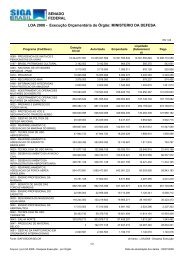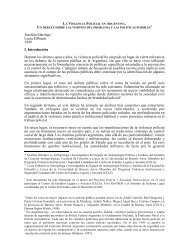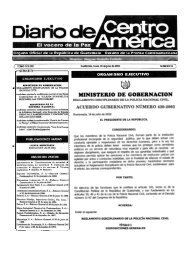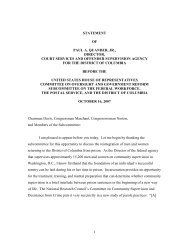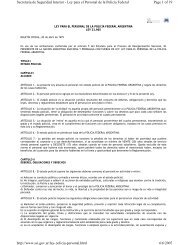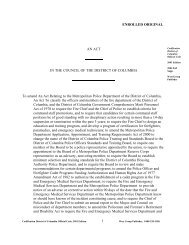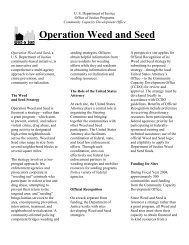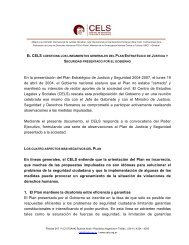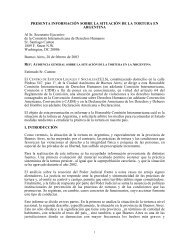Venezuela: The Life and Times of the Party System - Political ...
Venezuela: The Life and Times of the Party System - Political ...
Venezuela: The Life and Times of the Party System - Political ...
Create successful ePaper yourself
Turn your PDF publications into a flip-book with our unique Google optimized e-Paper software.
party’s vote <strong>and</strong> <strong>of</strong> growing abstentions; <strong>and</strong> 4. <strong>the</strong> relation between votes <strong>and</strong> representation in<br />
Congress.<br />
Electoral fragmentation comes in many forms. One obvious element is <strong>the</strong> sheer growth<br />
in <strong>the</strong> number <strong>of</strong> c<strong>and</strong>idates <strong>and</strong> parties seeking <strong>of</strong>fice. Three c<strong>and</strong>idates competed for <strong>the</strong><br />
presidency in 1958, twenty-three in 1988; eight parties presented legislative slates in <strong>the</strong> first<br />
election, compared to seventy-eight thirty years later. Although <strong>the</strong>se numbers are impressive,<br />
<strong>the</strong>y need to be treated with care. Although a growing number <strong>and</strong> variety <strong>of</strong> groups have sought<br />
<strong>the</strong> presidency, only AD <strong>and</strong> COPEI have won it. Moreover, <strong>the</strong>se two parties have never<br />
combined for less than half <strong>the</strong> total vote, with that low level coming only at <strong>the</strong> high-water marks<br />
<strong>of</strong> electoral dispersion, in 1963 <strong>and</strong> 1968. Since 1968, <strong>the</strong>ir joint domination has exp<strong>and</strong>ed to<br />
account for over 90 percent <strong>of</strong> <strong>the</strong> presidential vote during <strong>the</strong> 1980s (Table 5).<br />
With respect to legislative elections, despite <strong>the</strong> fact that almost ten times more parties<br />
competed in 1988 than thirty years earlier, <strong>the</strong> number gaining at least one deputy increased only<br />
from four to eleven over <strong>the</strong> same period. That high point was reached in 1973 <strong>and</strong> has not<br />
increased since, although <strong>the</strong> composition <strong>of</strong> <strong>the</strong> group <strong>of</strong> winners has changed substantially.<br />
This result is all <strong>the</strong> more impressive given <strong>Venezuela</strong>’s generous proportional representation<br />
system, which allocates additional seats by national electoral quotient after results are decided<br />
within states <strong>and</strong> territories. <strong>The</strong> data in Tables 3 <strong>and</strong> 4 affirm <strong>the</strong> long-term trend <strong>of</strong> controlled<br />
fragmentation <strong>and</strong> gradually consolidated domination by AD <strong>and</strong> COPEI.<br />
Throughout <strong>the</strong> thirty years <strong>of</strong> modern democratic politics, AD has never yielded its<br />
position as <strong>the</strong> single biggest party in ei<strong>the</strong>r house <strong>of</strong> congress. COPEI has gradually risen to a<br />
consistent second place, even in elections where its presidential c<strong>and</strong>idate won strongly as was<br />
<strong>the</strong> case in 1978. <strong>The</strong> rest <strong>of</strong> <strong>the</strong> votes (<strong>and</strong> seats) have been divided among parties that rarely<br />
survived more than a decade (two electoral periods in <strong>Venezuela</strong>) with any significant strength.<br />
Of all <strong>the</strong> parties that have arisen thus far to challenge AD, COPEI, <strong>and</strong> <strong>the</strong> pattern <strong>of</strong> joint<br />
domination, only MAS has resisted <strong>the</strong> trend. C<strong>and</strong>idates from MAS have now competed<br />
successfully in four elections, holding <strong>the</strong>ir own in <strong>the</strong> first three <strong>and</strong> growing strongly in votes <strong>and</strong><br />
seats in 1988. We suggest below that recent electoral reforms favor continued gradual growth for<br />
MAS, especially in legislative elections <strong>and</strong> in votes at <strong>the</strong> subnational level.<br />
<strong>The</strong> evolution <strong>of</strong> competition warrants separate attention. <strong>The</strong> decade after 1958 was<br />
marked by steady decline for AD, uninterrupted growth for COPEI, <strong>and</strong> <strong>the</strong> rise <strong>and</strong> fall <strong>of</strong> a<br />
number <strong>of</strong> electoral phenomena. Although elections became more competitive in <strong>the</strong>se years,<br />
this competition lacked coherence or enduring structure. Growing dispersion <strong>of</strong> <strong>the</strong> vote raised<br />
fears about fragmentation <strong>and</strong> possible atomization <strong>of</strong> <strong>the</strong> party system. <strong>The</strong> 1968 elections were<br />
<strong>the</strong> high-water mark <strong>of</strong> electoral dispersion in <strong>Venezuela</strong>. Nine major parties (<strong>and</strong> countless<br />
minor groups) competed for public <strong>of</strong>fice, with none gaining more than 30 percent <strong>of</strong> <strong>the</strong> total



